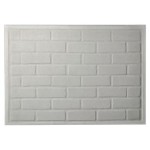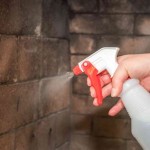Reface A Brick Fireplace With Stone Veneer
Refacing a brick fireplace with stone veneer is a popular home improvement project that can dramatically transform the appearance of a living space. This process involves covering an existing brick fireplace with a layer of manufactured or natural stone, creating a more rustic, modern, or sophisticated aesthetic. Stone veneer offers a cost-effective alternative to building a new fireplace from scratch, allowing homeowners to achieve the desired look without extensive demolition and reconstruction.
Before commencing the project, careful planning and preparation are essential. The existing brick fireplace should be thoroughly inspected for any structural damage or deterioration. Loose or crumbling bricks must be repaired or replaced to ensure a stable base for the stone veneer. Cleaning the brick surface is also crucial; any dirt, soot, or grease must be removed to promote proper adhesion of the mortar. Wire brushing or pressure washing can effectively clean the brick, and a bonding agent may be applied to further enhance adhesion.
Selecting the appropriate stone veneer is a critical decision. Both manufactured and natural stone veneer are available in a wide range of styles, colors, and textures. Manufactured stone veneer is typically lighter and more affordable than natural stone, and it offers consistent quality and color. Natural stone veneer, on the other hand, provides a unique, organic look and feel. The choice between the two depends on personal preferences, budget constraints, and the desired aesthetic of the fireplace.
Preparing the Fireplace Surface
Preparing the brick surface for stone veneer application involves several key steps. The first step is to thoroughly clean the existing brick. This involves removing any loose debris, dirt, soot, or paint. A wire brush can be used to scrub the surface, and a pressure washer may be necessary for more stubborn grime. After cleaning, the surface should be allowed to dry completely. In some cases, a bonding agent might be applied to the brick to improve the adhesion of the mortar. These bonding agents are typically liquid polymers that create a stronger bond between the brick and the mortar.
Once the brick is clean and dry, a metal lath is often attached to the surface. Metal lath provides a mechanical key for the mortar, ensuring that the stone veneer adheres securely to the brick. The lath is typically attached using nails or screws, and it should be overlapped at the seams to create a continuous surface. Care should be taken to ensure the lath is securely fastened and that it covers the entire surface that will be covered with stone veneer. This step is critical for the long-term stability of the refaced fireplace.
After the metal lath is installed, a scratch coat of mortar is applied. This layer of mortar provides a base for the stone veneer and helps to create an even surface. The scratch coat should be applied uniformly over the metal lath and then scratched with a notched trowel to create grooves. These grooves provide a better surface for the stone veneer to adhere to. The scratch coat should be allowed to cure for at least 24 hours before proceeding with the installation of the stone veneer itself. Proper curing is essential to ensure the mortar achieves its full strength and bonding capabilities.
Installing the Stone Veneer
The installation of the stone veneer is a meticulous process that requires attention to detail. Before beginning the installation, the stones should be laid out on the ground to determine the desired pattern and arrangement. This allows for adjustments to be made before the stones are permanently attached to the wall. It is also important to mix and match the stones to create a natural and visually appealing appearance. Varying the sizes, shapes, and colors of the stones can enhance the overall aesthetic.
Mortar is applied to the back of each stone veneer piece using a trowel. The mortar should be applied generously, ensuring that the entire surface is covered. The stone is then pressed firmly against the scratch coat, and the excess mortar is squeezed out. It is important to maintain consistent spacing between the stones to create a uniform look. Spacers can be used to ensure that the gaps are even. The excess mortar that squeezes out from between the stones should be removed with a trowel, and the joints should be tooled to create a professional finish.
As the stone veneer is installed, it is important to check the level and alignment of each piece. A level can be used to ensure that the stones are installed straight, and a rubber mallet can be used to gently tap the stones into place. The mortar joints should be tooled as the stones are being installed to prevent the mortar from drying and becoming difficult to work with. Different tooling techniques can be used to create different looks. For example, a concave joint can be created using a rounded tool, while a flush joint can be created using a flat tool.
Finishing and Maintenance
Once the stone veneer has been installed and the mortar has cured, finishing touches can be applied to enhance the appearance of the fireplace. The mortar joints can be cleaned and polished to remove any excess mortar or debris. A sealant can also be applied to the stone veneer to protect it from moisture and staining. Sealants are available in a variety of finishes, including matte, satin, and gloss.
Maintaining a stone veneer fireplace involves regular cleaning and inspection. The stone veneer should be cleaned periodically with a soft brush and mild detergent to remove any dirt or dust. Care should be taken to avoid using abrasive cleaners or harsh chemicals, as these can damage the stone. The mortar joints should also be inspected regularly for any cracks or damage. Any cracks should be repaired promptly to prevent water from penetrating behind the stone veneer.
In some cases, the stone veneer may require periodic resealing. The frequency of resealing depends on the type of stone veneer and the environmental conditions. Homes located in areas with high humidity or frequent rainfall may require more frequent resealing. By following these maintenance tips, a stone veneer fireplace can be kept in good condition for many years to come, enhancing the beauty and value of the home.

Reface A Fireplace With The Look Of Stone Or Brick Barron Designs

Refacing A Fireplace With Stone Veneer Horizon

Pin By Tarra Wills Efkarpidis On For The Home Brick Fireplace Remodel Stone

Stone Veneer Over A Brick Fireplace Updates The Look

Brickfireplaceideas Com Brick Fireplace Makeover Home Remodel

Stone Veneer Over A Brick Fireplace Updates The Look

Refacing Fireplace And Chimney Authority

Faux Stone Panels For Fireplaces

Stone Fireplace Refacing Reface Brick Selex

Faux Stone Panels For Fireplaces








